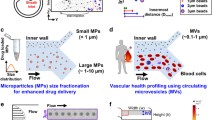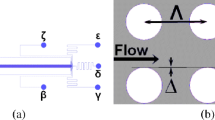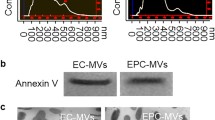Abstract
Microvesicles (MVs) are of great interest for the biomedical field as novel diagnostics biomarkers. MV research, however, is still impaired by the lack of standardization of the analysis methods. In this study, our goals were to develop a method for the reproducible generation of an MV population from cell culture, to compare the sizing of MVs by atomic force microscopy (AFM) and nanoparticle tracking analysis (NTA) and to develop an MV array allowing the sizing and phenotyping of MVs simultaneously with the AFM as a read-out. MVs were isolated from apoptotic human umbilical vein endothelial cells (HUVECs) and had a mean size of 115 nm as measured by AFM and of 197 nm as measured by NTA. MVs isolated from apoptotic and control HUVECs could not be distinguished by their size (p > 0.05). HUVECs and their released MVs shared the same phenotype (positive for endothelial markers CD31 and CD146 and negative for platelet marker CD42b). Our method generated MVs with a concentration which was reproducible within a range of 20%. This is a relevant model system for medical applications. The size of the MVs was larger as measured using NTA compared to that using AFM. The MV array was efficient to characterize the surface markers of MVs and has the potential to identify the cellular origins of MVs in patient samples.







Similar content being viewed by others

References
Aatonen, M.T., Öhman, T., Nyman, T.A., Laitinen, S., Grönholm, M., & Siljander, P.R.-M. (2014). Isolation and characterization of platelet-derived extracellular vesicles. Journal of Extracellular Vesicles, 3, 24692.
Angelot, F., Seillès, E., Biichlé, S., Berda, Y., Gaugler, B., Plumas, J., Chaperot, L., Dignat-George, F., Tiberghien, P., Saas, P., & Garnache-Ottou, F. (2009). Endothelial cell-derived microparticles induce plasmacytoid dendritic cell maturation: potential implications in inflammatory diseases. Haematologica, 94 (11), 1502–12.
Ashcroft, B.A., de Sonneville, J., Yuana, Y., Osanto, S., Bertina, R., Kuil, M.E., & Oosterkamp, T.H. (2012). Determination of the size distribution of blood microparticles directly in plasma using atomic force microscopy and microfluidics. Biomedical microdevices, 14(4), 641–9.
Ayers, L., Kohler, M., Harrison, P., Sargent, I., Dragovic, R., Schaap, M., Nieuwland, R., Brooks, S.A., & Ferry, B. (2011). Measurement of circulating cell-derived microparticles by flow cytometry: sources of variability within the assay. Thrombosis Research, 127(4), 370–377.
Bagley, R.G., Walter-Yohrling, J., Cao, X., Weber, W., Simons, B., Cook, B.P., Chartrand, S.D., Wang, C., Madden, S.L., & Teicher, B.A. (2003). Endothelial precursor cells as a model of tumor endothelium: characterization and comparison with mature endothelial cells. Cancer research, 63(18), 5866–5873.
Bardin, N. (2001). Identification of CD146 as a component of the endothelial junction involved in the control of cell-cell cohesion. Blood, 98(13), 3677–3684.
Bertrand, R., Solary, E., O’Connor, P., Kohn, K.W., & Pommier, Y. (1994). Induction of a common pathway of apoptosis by staurosporine. Experimental cell research, 211(2), 314–321.
Boulanger, C.M., Amabile, N., & Tedgui, A. (2006). Circulating microparticles: a potential prognostic marker for atherosclerotic vascular disease. Hypertension, 48(2), 180–186.
Burger, D., Schock, S., Thompson, C.S., Montezano, A.C., Hakim, A.M., & Touyz, R.M. (2013). Microparticles: biomarkers and beyond. Clinical science (London England : 1979), 124(7), 423–41.
Buzas, E.I., György, B., Nagy, G., Falus, A., & Gay, S. (2014). Emerging role of extracellular vesicles in inflammatory diseases. Nature Reviews. Rheumatology, 10(6), 356–64.
Chandler, W.L., Yeung, W., & Tait, J.F. (2011). A new microparticle size calibration standard for use in measuring smaller microparticles using a new flow cytometer. Journal of thrombosis and haemostasis, 9(6), 1216–24.
Chironi, G.N., Boulanger, C.M., Simon, A., Dignat-George, F., Freyssinet, J.-M., & Tedgui, A. (2009). Endothelial microparticles in diseases. Cell and tissue research, 335(1), 143–51.
Cocucci, E., Racchetti, G., & Meldolesi, J. (2009). Shedding microvesicles: artefacts no more. Trends in cell biology, 19(2), 43–51.
Combes, V., Simon, A.C., Grau, G.E., Arnoux, D., Camoin, L., Sabatier, F., Mutin, M., Sanmarco, M., Sampol, J., & Dignat-George, F. (1999). In vitro generation of endothelial microparticles and possible prothrombotic activity in patients with lupus anticoagulant. The Journal of clinical investigation, 104(1), 93–102.
Coumans, F.A.W., van der Pol, E., Böing, A.N., Hajji, N., Sturk, G., van Leeuwen, T.G., & Nieuwland, R. (2014). Reproducible extracellular vesicle size and concentration determination with tunable resistive pulse sensing. Journal of Extracellular Vesicles, 3, 25922.
Dignat-George, F., & Boulanger, C.M. (2011). The many faces of endothelial microparticles. Arteriosclerosis, thrombosis, and vascular biology, 31(1), 27–33.
Dragovic, R.A., Gardiner, C., Brooks, A.S., Tannetta, D.S., Ferguson, D.J.P., Hole, P., Carr, B., Redman, C.W.G., Harris, A.L., Dobson, P.J., Harrison, P., & Sargent, I.L. (2011). Sizing and phenotyping of cellular vesicles using nanoparticle tracking analysis. Nanomedicine : nanotechnology, biology, and medicine, 7(6), 780–788.
Eitan, E., Zhang, S., Witwer, K.W., & Mattson, M.P. (2015). Extracellular vesicle–depleted fetal bovine and human sera have reduced capacity to support cell growth. Journal of Extracellular Vesicles, 4, 26373.
Elmore, S. (2007). Apoptosis: a review of programmed cell death. Toxicologic pathology, 35(4), 495–516.
Fernandes, E., Martins, V.C., Nóbrega, C., Carvalho, C.M., Cardoso, F.A., Cardoso, S., Dias, J., Deng, D., Kluskens, L.D., Freitas, P.P., & Azeredo, J. (2014). A bacteriophage detection tool for viability assessment of Salmonella cells. Biosensors & bioelectronics, 52, 239–46.
Gardiner, C., Ferreira, Y.J, Dragovic, R.A, Redman, C.W.G., & Sargent, I.L. (2013). Extracellular vesicle sizing and enumeration by nanoparticle tracking analysis. Journal of extracellular vesicles, 2, 19671.
Gardiner, C., Harrison, P., Belting, M., Böing, A., Campello, E., Carter, B.S., Collier, M.E., Coumans, F., Ettelaie, C., van Es, N., Hochberg, F.H., Mackman, N., Rennert, R.C., Thaler, J., Rak, J., & Nieuwland, R. (2015). Extracellular vesicles, tissue factor, cancer and thrombosis—discussion themes of the ISEV 2014 Educational Day. Journal of extracellular vesicles, 4, 26901.
Gelderman, M.P., & Simak, J. (2008). Flow cytometric analysis of cell membrane microparticles. Methods in molecular biology, 484, 79–93.
Gercel-Taylor, C., Atay, S., Tullis, R.H., Kesimer, M., & Taylor, D.D. (2012). Nanoparticle analysis of circulating cell-derived vesicles in ovarian cancer patients. Analytical biochemistry, 428(1), 44–53.
Gheldof, D., Hardij, J., Cecchet, F., Chatelain, B., Dogné, J.-M., & Mullier, F. (2013). Thrombin generation assay and transmission electron microscopy: a useful combination to study tissue factor-bearing microvesicles. Journal of Extracellular Vesicles, 2, 19728.
Gong, J., Jaiswal, R., Dalla, P., Luk, F., & Bebawy, M. (2015). Microparticles in cancer a review of recent developments and the potential for clinical application. Seminars in Cell & Developmental Biology, 40, 35–40.
Hardij, J., Cecchet, F., Berquand, A., Gheldof, D., Chatelain, C., Mullier, F., Chatelain, B., & Dogné J.-M. (2013). Characterisation of tissue factor-bearing extracellular vesicles with AFM: comparison of air-tapping-mode AFM and liquid Peak Force AFM. Journal of Extracellular Vesicles, 2, 21045.
Hessler, J.A., Budor, A., Putchakayala, K., Mecke, A., Rieger, D., Banaszak Holl, M.M., Orr, B.G., Bielinska, A., Beals, J., & Baker, J. (2005). Atomic force microscopy study of early morphological changes during apoptosis. Langmuir, 21(20), 9280–9286.
Issman, L., Brenner, B., Talmon, Y., & Aharon, A. (2013). Cryogenic transmission electron microscopy nanostructural study of shed microparticles. PloS one, 8(12), e83680.
Jørgensen, M., Bæk, R., Pedersen, S., Søndergaard, E.K.L., Kristensen, S.R., & Varming, K. (2013). Extracellular Vesicle (EV) Array: microarray capturing of exosomes and other extracellular vesicles for multiplexed phenotyping. Journal of extracellular vesicles, 2, 20920.
Jørgensen, M.M., Bæk, R., & Varming, K. (2015). Potentials and capabilities of the extracellular vesicle (EV) array. Journal of extracellular vesicles, 4, 26048.
Kabir, J., Lobo, M., & Zachary, I. (2002). Staurosporine induces endothelial cell apoptosis via focal adhesion kinase dephosphorylation and focal adhesion disassembly independent of focal adhesion kinase proteolysis. Biochemical Journal, 367(1), 145–155.
Kim, K.S., Cho, C.H., Park, E.K., Jung, M.-H., Yoon, K.-S., & Park, H.-K. (2012). AFM-detected apoptotic changes in morphology and biophysical property caused by paclitaxel in Ishikawa and HeLa cells. PloS one, 7(1), e30066.
Laffont, B., Corduan, A., Plé, H., Duchez, A.-C., Cloutier, N., Boilard, E., & Provost, P. (2013). Activated platelets can deliver mRNA regulatory Ago2 microRNA complexes to endothelial cells via microparticles. Blood, 122(2), 253–61.
Latham, S.L., Tiberti, N., Gokoolparsadh, N., Holdaway, K., Couraud, P.O. , Grau, G.E.R., & Combes, V. (2015). Immuno-analysis of microparticles: probing at the limits of detection. Scientific reports, 5, 16314.
Lawrie, A.S., Albanyan, A., Cardigan, R.A., Mackie, I.J., & Harrison, P. (2009). Microparticle sizing by dynamic light scattering in fresh-frozen plasma. Vox sanguinis, 96(3), 206–212.
Leong, H.S., Podor, T.J., Manocha, B., & Lewis, J.D. (2011). Validation of flow cytometric detection of platelet microparticles and liposomes by atomic force microscopy. Journal of thrombosis and haemostasis, 9(12), 2466–76.
Leroyer, A.S, Anfosso, F., Lacroix, R., Sabatier, F., Simoncini, S., Njock, S.M., Jourde, N., Brunet, P., Camoin-Jau, L., Sampol, J., & Dignat-George, F. (2010). Endothelial-derived microparticles: biological conveyors at the crossroad of inflammation, thrombosis and angiogenesis. Thrombosis and haemostasis, 104(3), 456–63.
Martins, S.S.A., Martins, V.C., Cardoso, F.A. , Freitas, P.P., & Fonseca, L.P. (2012). Waterborne pathogen detection using a magnetoresistive immuno-chip. In Tiquia-Arashiro, S.M. (Ed.) Molecular Biological Technologies for Ocean Sensing SE - 13, Springer Protocols Handbooks (pp. 263–288). New York City: Humana Press.
Mege, D., Panicot-Dubois, L., Ouaissi, M., Robert, S., Sielezneff, I., Sastre, B., Dignat-George, F., & Dubois, C. (2016). The origin and concentration of circulating microparticles differ according to cancer type and evolution: a prospective single-center study. International Journal of Cancer. Journal International du Cancer, 138(4), 939–48.
Nicolet, A., Meli, F., van der Pol, E., Yuana, Y., Gollwitzer, C., Krumrey, M., Cizmar, P., Buhr, E., Pétry, J., Sebaihi, N., de Boeck, B., Fokkema, V., Bergmans, R., & Nieuwland, R. (2016). Inter-laboratory comparison on the size and stability of monodisperse and bimodal synthetic reference particles for standardization of extracellular vesicle measurements. Measurement Science and Technology, 27(3), 035701.
Nielsen, C.T., Østergaard, O., Johnsen, C., Jacobsen, S., & Heegaard, N.H.H. (2011). Distinct features of circulating microparticles and their relationship to clinical manifestations in systemic lupus erythematosus. Arthritis and rheumatism, 63(10), 3067–77.
Ordóñez, N.G. (2012). Immunohistochemical endothelial markers: a review. Advances in anatomic pathology, 19(5), 281–95.
Østergaard, O., Nielsen, CT., Iversen, L.V., Jacobsen, S., Tanassi, J.T., & Heegaard, N.H.H. (2012). Quantitative proteome profiling of normal human circulating microparticles. Journal of Proteome Research, 11(4), 2154–2163.
Reich, C.F., & Pisetsky, D.S. (2009). The content of DNA and RNA in microparticles released by Jurkat and HL-60 cells undergoing in vitro apoptosis. Experimental cell research, 315(5), 760–8.
Rieger, A.M., Nelson, K.L., Konowalchuk, J.D., & Barreda, D.R. (2011). Modified annexin V/propidium iodide apoptosis assay for accurate assessment of cell death. Journal of visualized experiments, (50), e2597. https://doi.org/10.3791/2597.
Rozlosnik, N., Gerstenberg, M.C., & Larsen, N.B. (2003). Effect of solvents and concentration on the formation of a self-assembled monolayer of octadecylsiloxane on silicon (001). Langmuir, 19(4), 1182–1188.
Shet, A.S., Aras, O., Gupta, K., Hass, M.J., Rausch, D.J., Saba, N., Koopmeiners, L., Key, N.S., & Hebbel, R.P. (2003). Sickle blood contains tissue factor-positive microparticles derived from endothelial cells and monocytes. Blood, 102(7), 2678–83.
Simák, J., Holada, K., & Vostal, J.G. (2002). Release of annexin V-binding membrane microparticles from cultured human umbilical vein endothelial cells after treatment with camptothecin . BMC cell biology, 3, 11.
Strasser, E.F., Happ, S., Weiss, D.R., Pfeiffer, A., Zimmermann, R., & Eckstein, R. (2013). Microparticle detection in platelet products by three different methods. Transfusion, 53(1), 156–66.
Sunkara, V., Woo, H.-K., & Cho, Y.-K. (2015). Emerging techniques in the isolation and characterization of extracellular vesicles and their roles in cancer diagnostics and prognostics. The Analyst, 141(2), 371–381.
Ullal, A.J., & Pisetsky, D.S. (2010). The release of microparticles by Jurkat leukemia T cells treated with staurosporine and related kinase inhibitors to induce apoptosis. Apoptosis, 15(5), 586–96.
van der Pol, E., Coumans, F.A.W., Grootemaat, A.E., Gardiner, C., Sargent, I.L., Harrison, P., Sturk, A., van Leeuwen, T.G., & Nieuwland, R. (2014). Particle size distribution of exosomes and microvesicles determined by transmission electron microscopy, flow cytometry, nanoparticle tracking analysis, and resistive pulse sensing. Journal of Thrombosis and Haemostasis, 12(7), 1182–1192.
van der Pol, E., Hoekstra, A.G., Sturk, A., Otto, C., van Leeuwen, T.G., & Nieuwland, R. (2010). Optical and non-optical methods for detection and characterization of microparticles and exosomes. Journal of thrombosis and haemostasis, 8(12), 2596– 607.
Shelke, G.V., Lässer, C., Gho, Y.S., & Lötvall, J. (2014). Importance of exosome depletion protocols to eliminate functional and RNA-containing extracellular vesicles from fetal bovine serum. Journal of Extracellular Vesicles, 3, 24783.
Wolf, P. (1967). The nature and significance of platelet products in human plasma. British Journal of Haematology, 13(3), 269–288.
Yuana, Y., Oosterkamp, T.H., Bahatyrova, S., Ashcroft, B., Garcia Rodriguez, P., Bertina, R.M., & Osanto, S. (2010). Atomic force microscopy: a novel approach to the detection of nanosized blood microparticles. Journal of thrombosis and haemostasis, 8(2), 315–23.
Acknowledgements
The author would like to thank Mark Holm Olsen for the preparation of the gold substrates and proof-reading, as well as Julie Kirkegaard for proof-reading and Christian Engelbrekt for providing training and access to the NTA. This work has been supported by the Technical University of Denmark.
Author information
Authors and Affiliations
Corresponding author
Appendix: Characterization of the Complete Growth Medium for HUVEC Culture
Appendix: Characterization of the Complete Growth Medium for HUVEC Culture
The different components of the complete growth medium of HUVECs were processed like the cell culture supernatants (centrifugation protocol described in Section 2.5) to assess if MVs or MV like particles were present in the complete growth medium before culture with the cells. Figure 7a shows the concentration of MVs detected in the processed aliquots of the medium components as measured with NTA. In the complete growth medium, 1.8 × 109 MVs/ml (SD + / − 5 × 108, corresponding to 28%) were detected. The levels of MVs measured in Ham’s F12K and the penicillin/streptomycin solution were below 10% of the level of MVs in the complete growth medium. However, the level of MVs in the FBS reached 1.1 × 1010 MVs/ml (SD + / − 3.6 × 108, corresponding to 3%), that was approximately ten times more than that in the complete medium. The size distributions of the MV from the complete growth medium and from the FBS (Fig. 7b) both show a main peak at 160 nm. The buffer used (phosphate-buffered saline, PBS) was filtered through a 0.1- μ m syringe filter prior of use and also had a low level of MVs (1.1 × 108 MVs/ml).
Rights and permissions
About this article
Cite this article
Cherre, S., Granberg, M., Østergaard, O. et al. Generation and Characterization of Cell-Derived Microvesicles from HUVECs. BioNanoSci. 8, 140–153 (2018). https://doi.org/10.1007/s12668-017-0438-7
Published:
Issue Date:
DOI: https://doi.org/10.1007/s12668-017-0438-7



